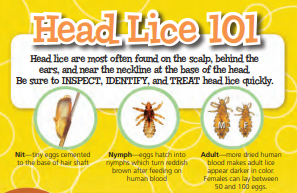- Very common! Between 6-12 million U.S. kids 3-11 years old get head lice each year.
- They are highly contagious but not dangerous.
- Clean hair can get lice too! Not only dirty hair get it.
- Lice can't jump, fly or swim.
- They cannot live on your pets.
- Unable to survive in your environment (couch, carpet, mattress, car). They need your body heat to survive!!!
If someone in your family does get lice. Act quickly as they can spread fast!- Screen your entire household
- Tell your school, friends, daycare, or anyone that is in contact with your child to avoid an outbreak.
- No need to wash entire wardrobe or overreact into a cleaning frenzy.
- Do not use toxic product as they are very harsh on children.
- Using olive oil, mayo, Listerine, tea tree oil, vinegar, or Vaseline will not work! They would be more of a preventative.
- Wash bedding, brushes, hair accessories that have been in contact within 24 hours.
Lice start out as eggs and are found at the base of your head close to your scalp. After they hatch they become nymphs. Takes about 7 days to mature and become an adult. Once they become an adult the females can lay up to 8 eggs a day and live up to 30 days on someone's untreated scalp. Eggs cannot hatch and lice cannot survive off of you. They need your blood supply and body heat from your scalp to survive! They only survive around 24 hours without your body heat.
Preventatives:- Don't share hats, brushes, headphones, or any items that can be transmitted by head-to-head contact.
- Check for lice once a week.
- Use preventatives as tea tree oil or sprays/washes from certain stores (located in the shampoo/conditioner isle).
Schools are not required to do lice checks. They are there for informing parents with treatment/prevenative information. We recommend all parents conduct weekly head checks on their children. For example, every Sunday night after bath time. By doing this, you will catch a case of lice early in efforts to stop/prevent an outbreak.
For more information please feel free to contact the school.
https://www.cdc.gov/parasites/lice/index.html
_1.PNG)
